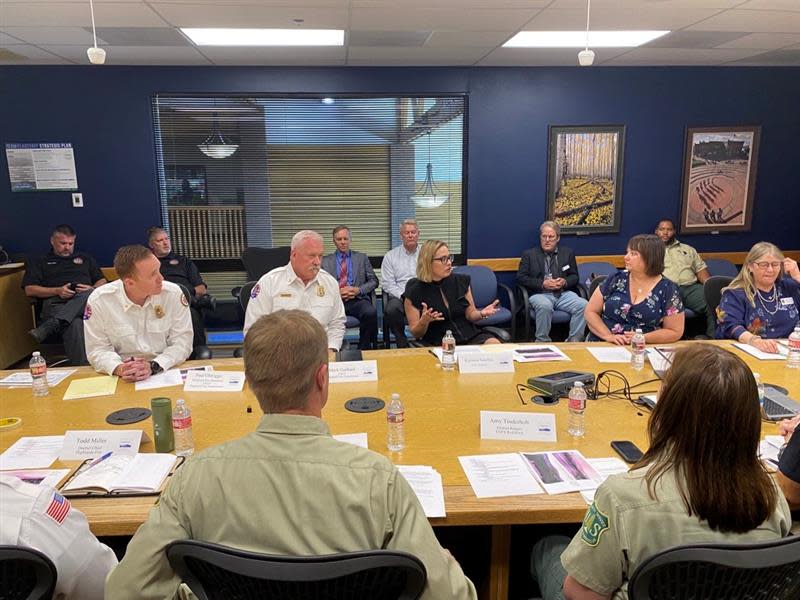Sen. Sinema talks wildland firefighting challenges with leaders in northern Arizona
- Oops!Something went wrong.Please try again later.
FLAGSTAFF — As numerous wildfires continue to burn across the state, Sen. Kyrsten Sinema met with local, state and federal leaders on the front line of wildland firefighting in northern Arizona on Tuesday to learn more about the challenges they continue to face and ways that she can help on a federal level.
"We're very much working under constrained conditions but these fire departments are the state's first responders to wildland incidents," Flagstaff Fire Chief Mark Gaillard said.
Workforce capacity, recruitment and retention are some of the biggest challenges facing wildland firefighting on all levels, officials said.
Struggles with recruitment and promotion
One of the biggest obstacles with recruitment and retention continues to be pay and benefits. The Bipartisan Infrastructure Law established a pay raise of up to $20,000 for federal wildland firefighters, which expires Sept. 30 of this year, and Sinema has since introduced a bill to make the pay raise permanent.

But State Forester Tom Torres said that the pay bump is creating a problem of its own between agencies. Right now, he estimated there is around a 15-20% pay disparity between local and federal firefighters. Cities and counties pay their local firefighters, which limits what Sinema can do at a federal level, but she did offer her office's resources for assistance with any future applications for grant funding.
"It just adds to the complexity of the problem to recruit, retain and maintain the firefighting force not only for the initial attack and extended attack but for that prescribed fire effort as well," Torres said.
Part of the problem stems from the fact that filling higher positions requires an immense investment.
For example, it takes about 10 years of work to become a qualified supervisor for wildland firefighters, Paul Otrogge, Flagstaff's wildland battalion chief, said.
But now, the pipeline that would guide those employees up the ladder has begun to dry up as experienced professionals move around and agencies receive fewer new applicants, resulting in a critical staffing shortage.
'It's all an emergency right now': Prescribed fires and air quality
"Experience is valuable everywhere but when we're a smaller agency and we lose that experience it really affects us and it takes us a long time to catch up," Highlands Fire District Chief Todd Miller said.
The problem is further exacerbated as fire agencies in Arizona begin to focus more on managed and prescribed fires which require highly-skilled firefighters and more resources.
"We're going to live with fire one way or another," Otrogge said. "Are we going to choose to kind of control that tempo and ease fire across landscape as intended or are we going to live with catastrophic wildfires? Because it's going to be one of the two."
As a result, the state treated almost 10,000 acres through prescribed fires to restore health to ecosystems that depend on fire, three times more than in the past, Torres said.
But the need for more prescribed fires is also putting the state at risk of non-compliance with newly proposed air quality regulations from the Environmental Protection Agency. If imposed, the regulations would severely limit the state's ability to set prescribed fires and in turn, would result in more devastating emergencies, officials said.
"We're going to need some help having people recognize that this is better than just crisis fire," Gaillard said.
Sinema said she spends a lot of time at the capitol explaining the unique environment in the state and why these restrictions will not work in Arizona or elsewhere in the Mountain West.
"Places like Arizona are always out of compliance and it's not because of man-made activity," Sinema said. "We are out of compliance because of the environment in which we live."
"It is my intention to make sure they fully understand the ramifications of it before they move forward," she said.
Fire officials also expressed frustration with the limitations imposed on them by bureaucratic systems when it comes to sharing resources and staffing across jurisdictions. For example, the agencies have a lot more authority in calling in for extra resources for emergency fire suppression than they do when conducting prescribed fires.
Because of these constraints, the various agencies operate on a lot of "hand shake agreements" to collaborate on projects throughout the region, True Brown, deputy fire staff with the Coconino National Forest, said.
"To be able to do that under a more formalized system would go a long way," Brown said.
With her position as committee chair overseeing governmental operations, Sinema said that she is confident that she should be able to cut through some of the red tape getting in the way.
"That's something that we can do that doesn't have a price tag, those are the easiest kinds of things to pass in Congress," she said.
Lucinda Andreani, the Coconino County Flood Control District Supervisor who oversaw the devastating post-wildfire flooding across the county last summer, is also on a federal commission working to address many of the issues around wildland firefighting and mitigation. The commission's final report is expected to be released next month and with it, a long list of recommendations for congressional action, she told Sinema.
"It's all an emergency right now," Andreani said.
"Treating the forest, mechanical thinning, addressing all those issues are all an emergency right now or we are going to have more and more true emergencies," she said.
Reach the reporter at LLatch@gannett.com.
The Republic’s coverage of northern Arizona is funded, in part, with a grant from Report for America. To support regional Arizona news coverage like this, make a tax-deductible donation at supportjournalism.azcentral.com.
This article originally appeared on Arizona Republic: Sen. Sinema talks wildfire challenges with local, state, federal officials

